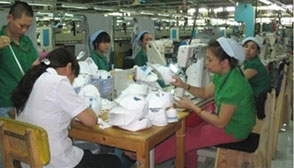Vietnam promotes gender equality
Prime Minister Nguyen Tan Dung has approved the national strategy on gender equality for the 2011-2020 period which is seen as a tool to bring the law on gender equality to life.
A VOV reporter interviewed Pham Ngoc Tien, Director General of the Gender Equality Department under the Ministry of Labour, Invalids, and Social Affairs, about the improvement of gender equality in Vietnam.
VOV: Are you confident that the national strategy will help resolve the gender inequality in Vietnam?
Mr. Tien: The overall objective of the strategy is to ensure the equality in opportunities to enjoy social, political,

Mr. Tien: While drafting the strategy, we have organized many seminars to get consultancy advice from ministries, relevant agencies, and localities, as well as international and Vietnamese non-governmental organizations. The strategy is based on the national strategy for advancement of women to 2010 and the two-year implementation of the law on gender equality. As the law on gender equality is integrated into many other proprammes and projects, all the main objectives of the strategy are connected to other strategies.
Besides, there are seven other objectives in line with groups of measures for the implementation of the strategy. One of them is increasing the participation of women in leadership and improving the state management capacity for gender equality.
VOV: Many people are still worried about the feasibility of the strategy. Do you think so?
Mr. Tien: That’s true. The authors themselves are also confronted with some controversial issues. Many objectives are too high, especially the one related to increasing women’s participation in leadership.
The strategy is part of the socio-economic development strategy and related to the previous documents such as Resolution 11-NQ/TW of the Political Bureau of the Communist Party of Vietnam on women’s work in the period of industrialization and modernization.
If the entire political systems co-ordinates efforts to carry out the strategy, we will be able to achieve all objectives by 2020.
VOV: Which group of measures needs to be applied?
Mr. Tien: In my opinion, communications and financial resources are the most two important tools to help us achieve the objectives.
While communications help raise public awareness and change their behaviour toward gender equality, financial resources are considered vital to success.
VOV: How has the strategy been implemented in localities?
Mr. Tien: Many localities have taken the initiative to carry out the strategy. Meanwhile, the MOLISA is about to introduce guidelines to help localities, ministries and relevant agencies to formulate the strategy.
In addition, we will hold a conference to review the national strategy for advancement of women in the 2010 period and develop a national programme on gender equality for the 2011-2015 period.
VOV: What are the most difficulties and which factors are needed to ensure the effectiveness of the strategy in localities?
Mr. Tien: The shortage of financial and human resources and skills are the biggest problems we are facing. Officials in charge of gender equality-related issues usually hold more than one positions. Only nine out of 63 provinces and cities nationwide have a department for gender equality.
VOV: Many people say that it is more practical to make the public and leaders fully aware of the need to solve all issues related to gender equality. What’s your opinion?
Mr. Tien: It is no easy task to solve all these issues within 10 years. What we should do now is to select and put the most effective measures in place.
VOV: Thank you very much!
(VOV) “Going to every alley, knocking on every door” to encourage people to make digital transformation
“Going to every alley, knocking on every door” to encourage people to make digital transformation
 Education branch’s Trade Union does activities for grassroots level
Education branch’s Trade Union does activities for grassroots level
 Binh Duong supports 90 billion VND to help eliminate temporary and dilapidated houses for poor and near-poor households in Quang Ngai
Binh Duong supports 90 billion VND to help eliminate temporary and dilapidated houses for poor and near-poor households in Quang Ngai
 Enterprises "race" to recruit workers at the end of the year
Enterprises "race" to recruit workers at the end of the year
 Female voters propose many ideas related to public healthcare and education
Female voters propose many ideas related to public healthcare and education
 Youth volunteerism in digital transformation
Youth volunteerism in digital transformation
 To ensure railway traffic safety and order
To ensure railway traffic safety and order
 Strengthening development of cultural life among employees
Strengthening development of cultural life among employees
 Youths helped with start-ups
Youths helped with start-ups
 Workers and quality lunches
Workers and quality lunches






